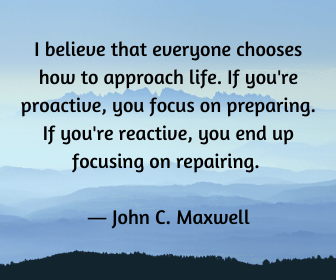What is the difference between proactive and reactive leadership?
Proactive leadership focuses on strategizing how a team will reach their objective, planning for avoiding or handling obstacles as they arise. Reactive leadership focuses on problems and how to fix them as they surface. Being proactive is commonly thought of as taking action and making things happen; being reactive is the handling of action that takes place.

Stephen R Covey was an American author, educator, motivator and speaker with a focus on various aspects of management/leadership. His best-selling book, “The 7 Habits of Highly Effective People” states the first habit is being proactive.
In essence, Covey states that problems fall into one of 3 areas: 1) problems that are directly under our control, 2) problems that are indirectly under our control (under the control of others whom we may influence), and 3) problems over which we have no control. Being proactive, based on Covey’s theory, is discovering in which of these three areas a problem falls and then putting the steps in place to solve the problem or change our way of viewing the problem. (Covey, 1989)
Let’s take a closer look at what it means to be proactive…
Characteristics of being proactive versus reactive:
Reactive:
- Each situation is taken into account in order to make decisions based on the most recent information
- More independent decisions are made by the leader regarding the team, which can be less collaborative with the leader and the team
- Since this type of leadership relies on the leader’s independent decisions, it tends to be more dictatorial, where the leader is telling the team what needs to take place, and the team is supposed to do it.
- Because being reactive is more reliant on the leader to make urgent decisions, this works well for those leaders who strongly value control of team
- Reactive leaders tend to have tight boundaries and follow rules, and are more like to use negative consequences to redirect
- Circumstances causing the reaction already have momentum; the situation is in the process of evolving when the leader gets involved. (Have you heard the saying that it takes a while to turn a large ship even a few degree? Sometimes, it may be better to start turning the ship far ahead of the actual need for it.)
- Changes can often take place more quickly because the leader is unilaterally making the decisions
- Since being reactive means that the leader is more apt to make independent decisions, they are relying more on their own solutions, which may not be the best
- Reactive leaders tend to be more task-oriented, versus focused on the end results
- Team may feel more like they’re being controlled and less able to direct the plan that affects them
- Because reactive leaders tend to focus on tasks, they look to find independent problems and provide fixes for them
- Since being reactive means focusing on problems, this way of leading can be stressful to the leader and the group.
Proactive:


- Proactive leaders plan for different contingencies; therefore, they can be better prepared with a plan of action
- Proactive leaders tend to be more coaching in nature
- Proactive leaders who are able to get their team to envision the objectives and get buy-in from the team, have group momentum toward a common goal
- The team can be more self-reliant, taking initiative for results
- Proactive leaders may gain more respect from their team because they help eliminate the problems or depth of the problems for the group
- Because there’s forethought and more focus on the end goal versus each problem that arises, being proactive in leadership can be less stressful for the leader and the group.
- Proactive leadership is more based on principles and less on policy and tasks.
- Leaders who are proactive are typically better at organizing. They envision a goal and all of the steps that they see they need to take to get there.
One of the results of proactive leadership is less stress on the leader and less stress on the team. Why?
We’ll use the Eisenhower Matrix to help explain this.
The Eisenhower Matrix is depiction of the most productive way to manage time. He developed it during his time in World War II, serving as a five-star general. He would often get pulled in many different directions, and he found that mentally compartmentalizing problems would help him determine the best use of his precious, and much-desired time.
The Eisenhower Matrix is based on the concept that tasks fall into one of four quadrants:

His idea was that, once you’re able to determine where a task falls in the matrix, you’re able to prioritize the order of those things on the list. Here’s more of a break down:
Quadrant I: These are urgent and important. These are crises. Because there’s a need to complete these tasks right away and they’re important, these tasks should be done immediately.
Examples of quadrant I tasks: taking care of family health concerns; fire-fighting; completing a report needed by the CEO to pitch the business the following day
Reactive leaders spend a lot of time completing activities in this quadrant. They uncover problems and put out figurative fires.
Quadrant II: These are not urgent but important tasks. These are longer-term goals. Planning, scheduling. These should be completed after taking care of Quadrant I.
Examples: Scheduling restaurant staff for the month; planning consultants’ milestones throughout a 3-month project to reach specified deliverables.
Proactive leaders spend time in quadrant II improving processes. They schedule communication sessions with their team to check on progress, brainstorm, discuss obstacles, etc. They network with other leaders.
Quadrant III: Not important, but urgent. Interruptions, information needed by another department that has no bearing on your department objectives, etc. These are often tasks that can be delegated to be done by someone with other time constraints and responsibilities. Reactive leaders can spend time here, as well since part of being reactive is focusing on what is urgent. Leaders should try to minimize these activities as much as possible to reduce stress and be most productive.
Examples: Compiling numbers for month-end report to upper management a week prior to the end of month; phone calls
Quadrant IV: Not important and not urgent. These are typically time-wasters and should be eliminated, if possible.
An example of a quadrant IV activity is talking about things with co-workers that don’t help you reach your objectives.
How does this relate to being proactive? They plan, schedule and organize, which also prevents crises, keeping more of the future tasks out of quadrant I. Because spending time in quadrant I can take more mental and sometimes physical energy, it tends to produce more stress for themselves and their team. Proactive leaders focus a lot of time on quadrant II.
So is being proactive as a leader always better than being reactionary?
Many leaders in various industries would be most efficient in reaching their goals if they adopt proactive behaviors. But, there are industries that are well-suited for having leadership that reacts to problems versus planning for best-case scenarios. Some industries, such as manufacturing, have a large amount of positions where the employee performs the same tasks in succession day after day. Leaders of these teams keep their employees on task, without may changes to the protocol. They handle problems as they arise, but don’t need forethought as to how to get to the end goal; they know their goals, know their tasks and deal with extenuating circumstances as they pop up.
Still other industries require a mixture of reactive and proactive leading. Farming is an example of an industry where those in charge plan for their season, but due to weather, regulatory changes, and a host of other variables, they regularly have to react to problems, solving them and putting contingency plans into place.

